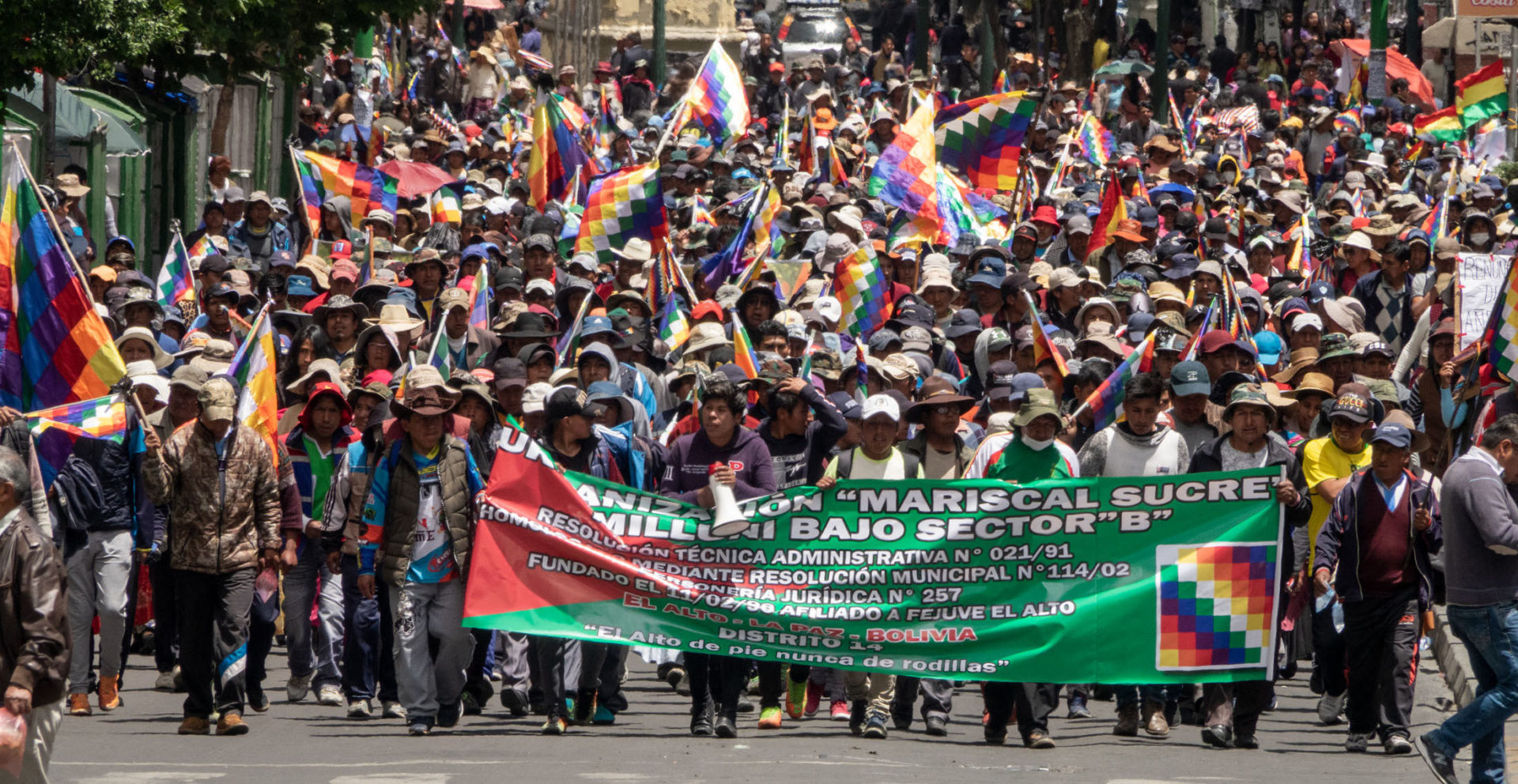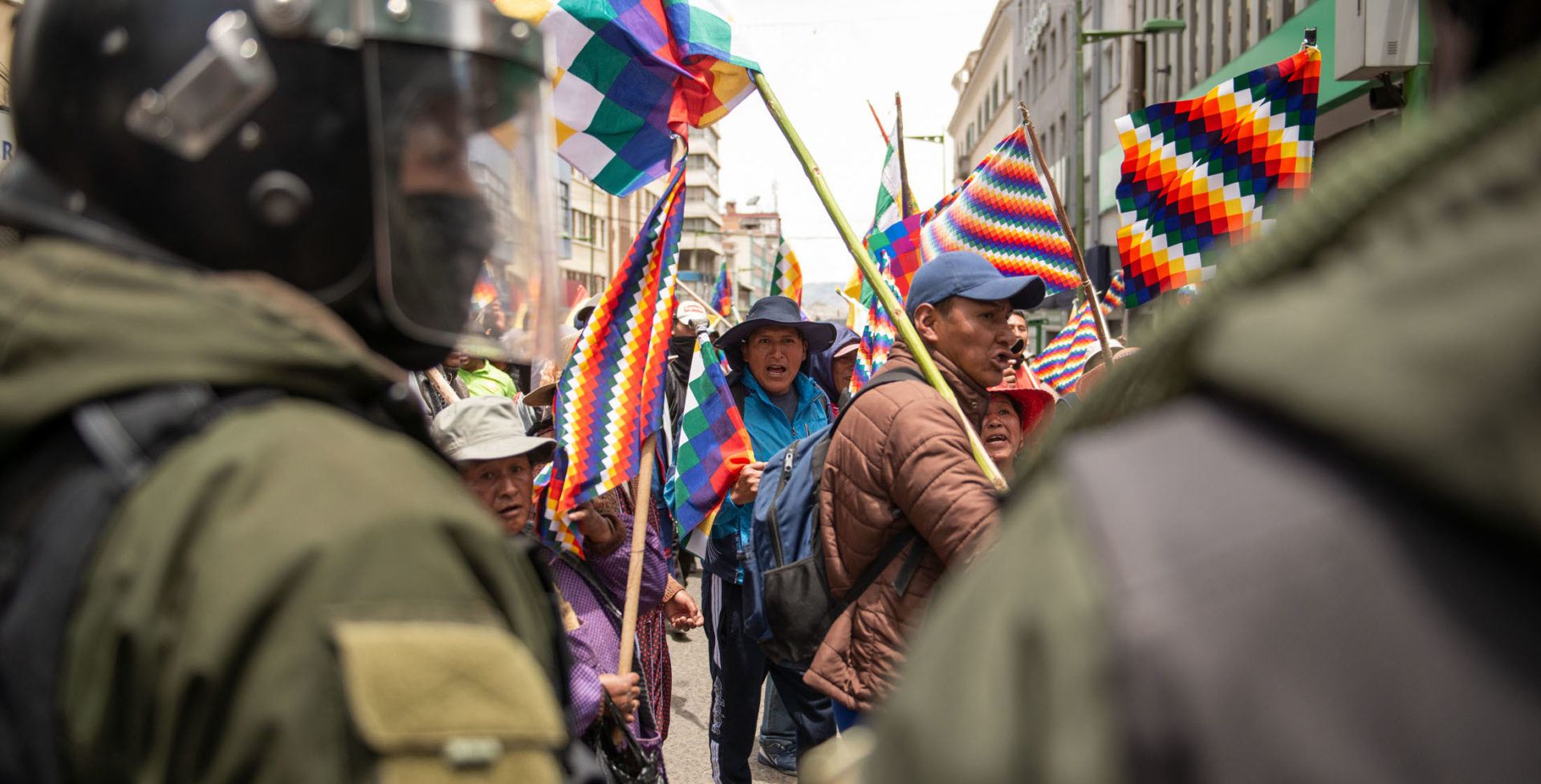Protesters in defense of the wiphala in La Paz. November 15, 2019. Photo: Radoslaw Czajkowski
The struggle for justice continues in post-coup Bolivia
- June 19, 2020
Land & Liberation
A brutal wave of repression followed the right’s seizure of power last November, but organizing for social and political change in Bolivia continues.
- Author
History is in the veins of La Paz, Bolivia, in the archives of the streets, the stains left by burning barricades, the bullet holes that scar government buildings. It marks the city itself.
Indigenous rebel Túpac Katari launched his 1781 siege against the Spanish from what is now the hilltop K’illi K’illi park. President Villarroel was hung from a lamp post by an angry crowd in the Plaza Murillo in 1946. Machine gun fire rained down in the San Pedro neighborhood during a coup in 1979. Protesters pulled train cars from the tracks and onto a highway during an uprising in 2003, blocking the military from entering El Alto.
Last November’s coup against President Evo Morales and his Movement Toward Socialism (MAS) government added another layer to this history.
When I visited La Paz in March, one woman in a middle-class neighborhood reproached me for taking a photo of the “Murderer Áñez” graffiti in front of her house, in reference to President Jeanine Áñez, who came to power through the coup.
“Why are you taking a picture? She is a good president,” she yelled at me. “She is our president.” The next day the graffiti was gone.
In defense of the wiphala
Anti-Morales protests followed the contested October 20 election, which pointed to another victory for the country’s first Indigenous president. The Organization of American States, a key Washington ally in the region, reported that the election was fraudulent, but a recent study found the OAS’s statistical analysis of the vote was flawed. At key moments in the conflict, the OAS boosted the narrative of fraud that the opposition had been promoting in the lead up to the vote, fanning the flames of protest against Morales.
Following weeks of mobilizations against the MAS, the police mutinied against the government, and the military asked Morales to step down. Right-wing senator Áñez was sworn in as president in front of an empty Congress on November 12 while the army patrolled the streets.
“The Bible has returned to the government palace,” Áñez declared upon taking office, wielding a massive Bible in front of a crowd of supporters.
Trump offered his blessing from the White House, saying Morales’ ouster was a “significant moment for democracy in the Western Hemisphere.”
Following the coup, police officers ripped the wiphala, a multicolored flag representing the many Indigenous nations of the Andes, off from their uniforms, and anti-Morales protesters publicly burned the historic flag.
Thousands of protesters then took to the streets in defense of the wiphala, bearing the colorful flag. During one dramatic moment in the central Plaza San Francisco in La Paz, Bolivian fighter planes flew low over a massive rally in defense of the wiphala in a haunting echo of past coups throughout Latin America.
“It was a coup. If the police and military support it like that, then yes, it’s a coup,” José Arce, a La Paz taxi driver told me.
A silence in the face of the coup
The Morales government had led the country since 2006, dramatically lowering poverty rates and expanding access to social services and political power for the country’s poor majority. It confronted US imperialism, and joined other leftist governments in the region in forging more economic and political sovereignty.Critics had long denounced the MAS’s centralization of power, corruption scandals and the negative environmental impact of extractivism. Morales also ignored the results of a 2016 referendum in which a majority voted against him running for president in 2019, a key grievance among anti-MAS protesters last year.
But for the MAS’s largely poor, Indigenous, rural base, Morales was a hero who had faced down the country’s racist oligarchy. This rural sector had greatly benefited from the MAS’s fourteen years in power, and Morales was one of the country’s most popular presidents in history because of it.
“Now the government of Áñez wants to privatize everything,” José the taxi driver told me.
When I visited La Paz, election season was in full swing and Áñez was one of a number of right-wing figures running against MAS presidential candidate and former minister of the economy Luis Arce. Morales, meanwhile, remains in exile in Argentina.
One Áñez campaign billboard towered over graffiti denouncing the “Traitor Police,” referring the police mutiny which helped paved the way for the coup. Those billboards used to be occupied by Morales during election seasons. In March, there was not a single MAS campaign sign in sight.
“There’s a silence in the face of this coup,” Bolivian human rights lawyer David Inca Apaza explained to me in a café near the presidential palace. He lamented the lack of social movements protesting the Áñez government due to a fear of repression.
“Those who did protest back then are now dead,” Inca said. “The government made it very clear that no mobilizations were going to be allowed because there would be bullets.”
Demanding justice
Following the right’s seizure of power in November, the Áñez government led a brutal wave of repression, including massacres in Senkata (El Alto) and Sacaba, which left over twenty people dead.
A new report now documents 96 cases of police and military torture and violence of demonstrators and passersby in El Alto, a largely Indigenous and working-class city bordering La Paz, during the post-coup repression in November.
Inca represents the families of victims of the Senkata massacre, where protesters and bystanders in El Alto were gunned down from military helicopters on November 19, 2019.
“It is very clear that the [Áñez] government’s position is to cover up those acts so that they cannot be brought to justice, either at the national or international level,” Inca explained.
Inca and the families of the victims of the Senkata massacre have presented a list of demands to the Áñez government.
“The first is the identification and punishment of the people who ordered that operation and killing, that the intellectual and material authors, those implicated in the event and the cover-up, be identified,” he explained.
“The second is medical attention. The third is food aid, another is aid with scholarships, for the children, the youth, for work. Another is economic relief for those who had financial debt. Because having died, having been injured, they cannot honor that debt with the bank.”
Following the state violence in Senkata last November, families of the victims of the massacre marched with hundreds of others down from El Alto into La Paz, carrying the coffins of deceased relatives and demanding justice.
“The motive of that march was primarily to show the world that there was a massacre and that they can’t cover their eyes to that reality,” Inca explained.
The marchers, bearing of the coffins of their loved ones, were met with teargas in downtown La Paz as police dispersed the crowd.
But the fight for justice continues. “Many of the women, the widows, the wives of the wounded, do not have a deep knowledge of the law,” Inca said. “But they have something more important than a human rights expert. They have the lived experience of what justice means.”
The true face of the right
As state repression under Áñez continues, various groups continue organizing for social and political change within and beyond the electoral realm.“The struggle of the Indigenous peoples did not begin with President Evo,” journalist Yolanda Mamani told Lavaca last December, “and so our actions didn’t end when he resigned. We are women in the struggle, and that’s how we will continue.”
Bolivia’s Supreme Electoral Tribunal recently proposed that presidential elections take place on September 6 of this year, but due to the political climate in the country and the health risks of COVID-19, this date could be subject to change.
“I always voted blank in past elections,” the La Paz taxi driver Arce explained to me, “but this election I will vote for the MAS. Why? Because we, the Indigenous people, have been discriminated against by the Áñez government. MAS will win the next elections because people now see the true face of the right. They will win because people on the bottom, the poor, support the MAS.”
Source URL — https://roarmag.org/essays/the-struggle-for-justice-continues-in-post-coup-bolivia/



